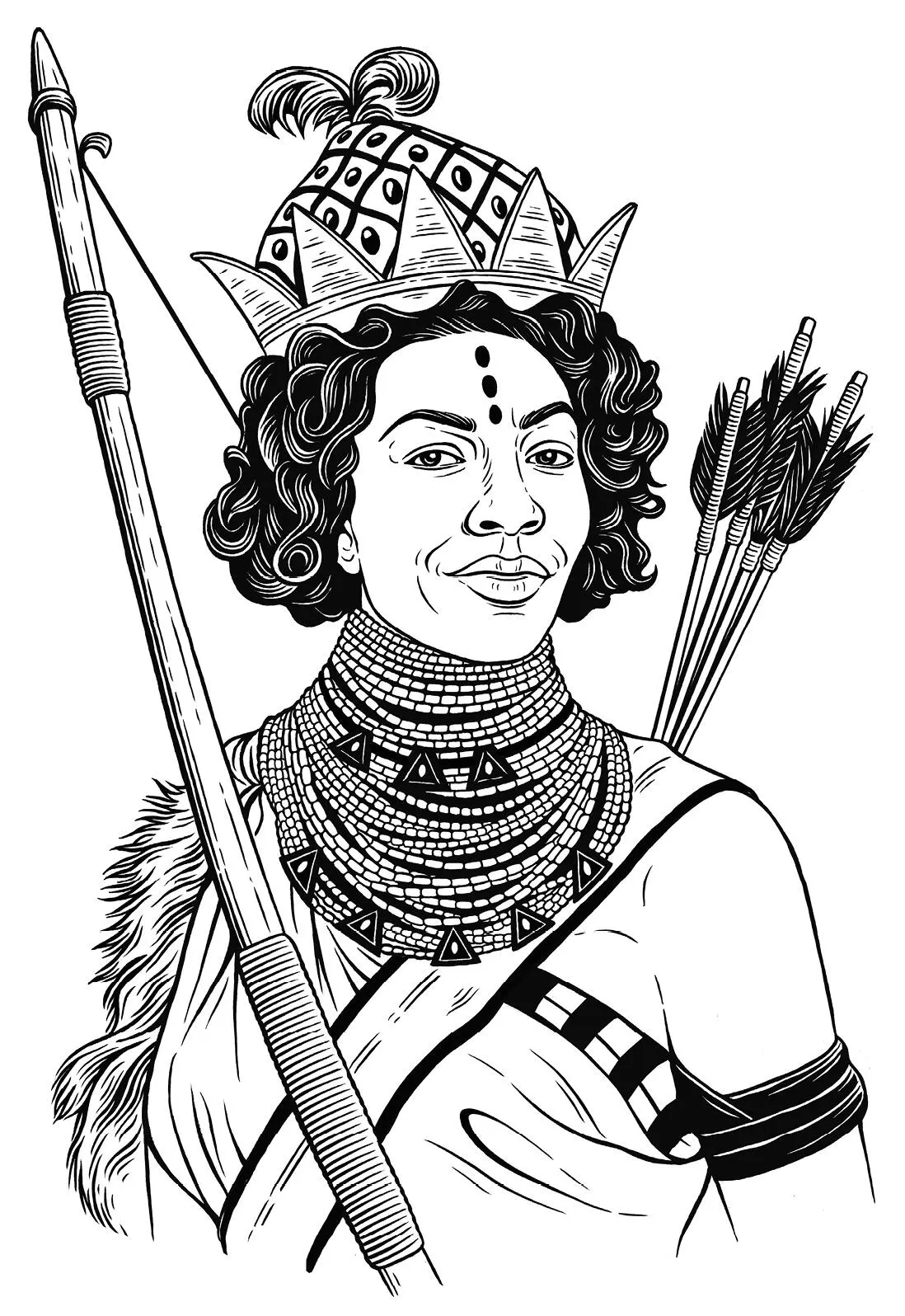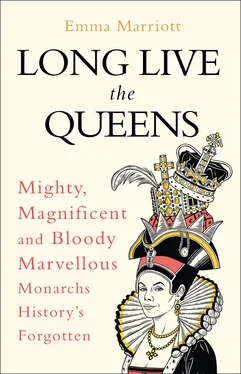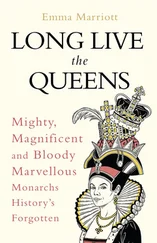Henrietta continued to try to raise money and arms in France, and she was later joined by her infant daughter Henrietta Anne and eldest son Charles. However, the King’s position gradually grew worse and in 1646 he was captured and taken prisoner by the Scots. Letters between the King and Queen were published, with parliamentary journalists mocking the Queen’s unfeminine behaviour as a woman who led armies and titled herself ‘generalissima’, indicating that it was she who lost the King his throne and who was the ‘wearer of the breeches’. Parliament eventually condemned the King for treason in January 1649 and on 30 January 1649 he stepped onto the scaffold at Banqueting House and was beheaded. Deeply shocked at the news, Henrietta focused instead on her children and on her faith, founding a convent in Chaillot in 1651, where she lived for much of the 1650s.
In 1652 Henrietta’s youngest son Henry was released from captivity and was sent to France. There, Henrietta sent him to a Jesuit school and attempted to convert him to Catholicism, much to the anger of her eldest son Charles. Already a staunch Protestant, Henry refused to listen to his mother on matters of religion and from the mid-1650s to his early death in 1660 she never again saw Henry and was alienated from Charles. Nonetheless, she was delighted to hear of Charles’s restoration to the throne in 1660, after which she visited England, returning another two times, but finally she returned to France where she felt most comfortable and where she eventually died in 1669.
Far from doing anything of little importance, Henrietta Maria was a leading Royalist figure who fought tirelessly for the King. Her open, and some would say defiant, Catholicism served to deepen divisions in Britain and she was deeply criticised for her involvement in politics and warfare. As Queen, she faced extraordinary dangers both in the form of vicious propaganda by her enemies and volleys of cannonball fire, and she was lucky to escape with her life.


Born: circa 1583
Died: 1663
The seventeenth-century African queen, Nzinga (also known as Njinga) is a national heroine in Angola. In the Western world, however, she is virtually unknown, despite her decades-long reign in which she skilfully navigated the ruthless power politics of the time, brilliantly playing off her rivals. Contemporary Europeans and later writers delighted in vilifying her as an uncivilised savage – no doubt to make themselves feel better about slave trading – and lurid stories tell of her slaughtering her enemies, murdering babies, and keeping a harem of cross-dressing slaves for her sexual gratification.
Whilst some of these tales smack of fantasy, European colonisers were engaged in very real acts of barbarity: namely the trade of African slaves to the New World. The growing demand for human labour in the mines and plantations of Brazil had led Portugal to seek control of city states along the Central African coast and by the early 1600s the slave markets in Angola were rapidly expanding. Local African rulers were faced with a dilemma: either resist the occupiers, which meant risking established trade opportunities (including selling members of rival or hostile tribes as slaves) or submitting to them and thereby losing their independence. It was at this point that we first hear of Nzinga, acting as the official negotiator with the Portuguese on behalf of her brother, the Ngola (King) of the Ndongo in central West Africa.
Nzinga was born into the royal family of Ndongo, one of the principal kingdoms in the region. Tradition says she was born with an umbilical cord around her neck, which foretold of future greatness. Her father, the King of Ndongo, favoured his bright daughter and she was allowed to accompany him on royal visits. When he died, her brother inherited the throne, after which Portuguese forces continued to sweep through the kingdom, abducting and selling thousands of its people into slavery. Nzinga’s task in 1622, as an envoy of her brother, was to negotiate with the Portuguese Governor, João Correia de Sousa, in the new settlement of Luanda (now the capital of Angola). The aim was to secure the independence of Ndongo whilst at the same time enlisting Portuguese help in expelling their rivals, the Imbangala, a fearsome warrior tribe, from the Ndongo kingdom. The story goes that when Nzinga met the Governor, he was sat on a velvet-covered chair, whilst she was given a mat to sit on. Unwilling to be treated as an inferior, she ordered one of her maid servants to get down on all fours so she could sit on her back during the discussion. The result was a peace treaty on equal terms, and Ndongo retained its independent status. One concession Nzinga did make to the Portuguese was that she converted to Catholicism, adopting the name Dona Ana de Sousa in honour of the Governor’s wife, a conversion that one suspects was done primarily for political reasons.
Two years later, Nzinga’s brother died – some say that Nzinga had him killed, along with her nephew (cue grisly bit) whose heart she ate afterwards. Whatever the truth, she assumed power as Queen Nzinga. The Portuguese, in the meantime, failed to honour the treaty and continued to raid her kingdom and enslave her people. By 1626, Nzinga was driven out of Ndongo by the Portuguese and she led her people further east to Matamba, where she conquered the Jaga tribe. There, she also offered sanctuary to runaway slaves and soldiers trained by the Portuguese, and formed her own militias. In alliance with former rival states, she led an army against the Portuguese in what would become a thirty-year war.
In 1641, the Dutch, with African allies, seized Luanda from the Portuguese and Nzinga swiftly joined forces with the new occupiers. She conducted a series of campaigns against the puppet monarch the Portuguese had put in place in Ndongo, and in 1643 she routed the Portuguese outside Mbaka. She secured further victories in 1647 and 1648 – and is reported to have rode out into battle with her troops dressed as a man – although an intervening defeat by the Portuguese had led to the capture of Nzinga’s sister, Mukumbu, whilst another captive sister who had been spying for Nzinga was reputedly drowned by the Portuguese in the Kwanza River. In 1648, the Portuguese recaptured Luanda and Nzinga was forced to retreat to Matamba, where she resisted Portuguese troops well into her sixties.
It is in Matamba where we have an eyewitness account of Queen Nzinga from the 1640s as written by the Dutch captain, Fuller, who had been put in charge of a body of men given to the service of the Queen. The Jaga, whom the Queen had conquered in Matamba, were said to have indulged in cannibalism and the infanticide of conquered enemies. Nzinga, for public effect, performed a ritual sacrifice wearing ‘man’s apparel’ of animal skins, with sword, axe and bow and arrow, leaping and striking two iron bells, before she selected her first victim, cutting off his head and drinking his blood.
Again according to Fuller (and by this time Nzinga would have been well over sixty), she kept fifty or sixty men in a harem, who were allowed wives but any infants who were conceived had to be killed. Similarly, it was said that she selected some of her favourites of these men to dress in women’s clothes. The story obviously titillated the nineteenth-century French nobleman the Marquis de Sade, who revived the tale in his Philosophy in the Boudoir , claiming that Nzinga immolated each lover after a night together.
Читать дальше








![Джеффри Арчер - The Short, the Long and the Tall [С иллюстрациями]](/books/388600/dzheffri-archer-the-short-the-long-and-the-tall-s-thumb.webp)





